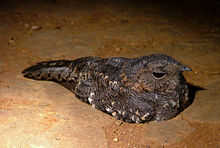Band-winged nightjar
| Band-winged nightjar | |
|---|---|
 |
|
 |
|
| Scientific classification | |
| Kingdom: | Animalia |
| Phylum: | Chordata |
| Class: | Aves |
| Order: | Caprimulgiformes |
| Family: | Caprimulgidae |
| Genus: | Systellura |
| Species: | S. longirostris |
| Binomial name | |
|
Systellura longirostris (Bonaparte, 1825) |
|
| Subspecies | |
|
See text |
|
See text
The band-winged nightjar or greater band-winged nightjar (Systellura longirostris) is a species of nightjar in the family Caprimulgidae. It is widespread in South America, where it is found in the Andes, Venezuelan Coastal Range, Santa Marta Mountains, Tepuis, most of Chile, Argentina, Paraguay, Uruguay and eastern Brazil. It occurs in a wide range of habitats, from the edge of humid montane forest to shrubby semi-deserts and urban rooftops.
According to one morphological characterization there could be two groupings of subspecies distributed in different regions. The first grouping would be characterized as having a greyish-brown color (lowland regions in middle, east and south of range) and the other subspecies grouping has a blackish-brown coloration (north and west in uplands). All individuals in each group are presumed to vary in coloration and are sexually dimorphic.
Eight subspecies have been recognized, including two new subspecies, one from Chile and another from Brazil which have been described within the last few years. Tschudi's nightjar was formerly also considered a subspecies, but has now been elevated to species rank. Recently, it has been suggested that both S. l. roraimae and S. l. ruficervix should be treated as separate species.
Over its large range, there are significant variations in its morphology, but, as suggested by its common name, it always has a distinctive band in the wing (best visible in flight), which is white in the male, buff in the female.
This nightjar has a length that varies from 20–27 cm (for Ecuador, 21.5 to 23 cm). The iris, bill, legs and feet vary from a brown to a blackish brown. At the upper side a greyish-brown, blackish-brown, brownish-orange, pale yellowish-brown and greyish-white coloration can be distinguished. The rear of the neck is from a brownish orange to a yellowish brown. Wing-coverts acquire a greyish-brown coloration accompanied with dense spotted yellowish to greyish brown. Scapulars are blackish brown. In males sometimes white and in females sometimes a yellowish-brown mark around the lower throat. Belly and flanks become brown or yellowish brown. When flight sights, male has a white marks at the edge of the first four primaries, as well with a white band on the first and fourth rectrices. The female does not possess the white mark on the tail.
...
Wikipedia

